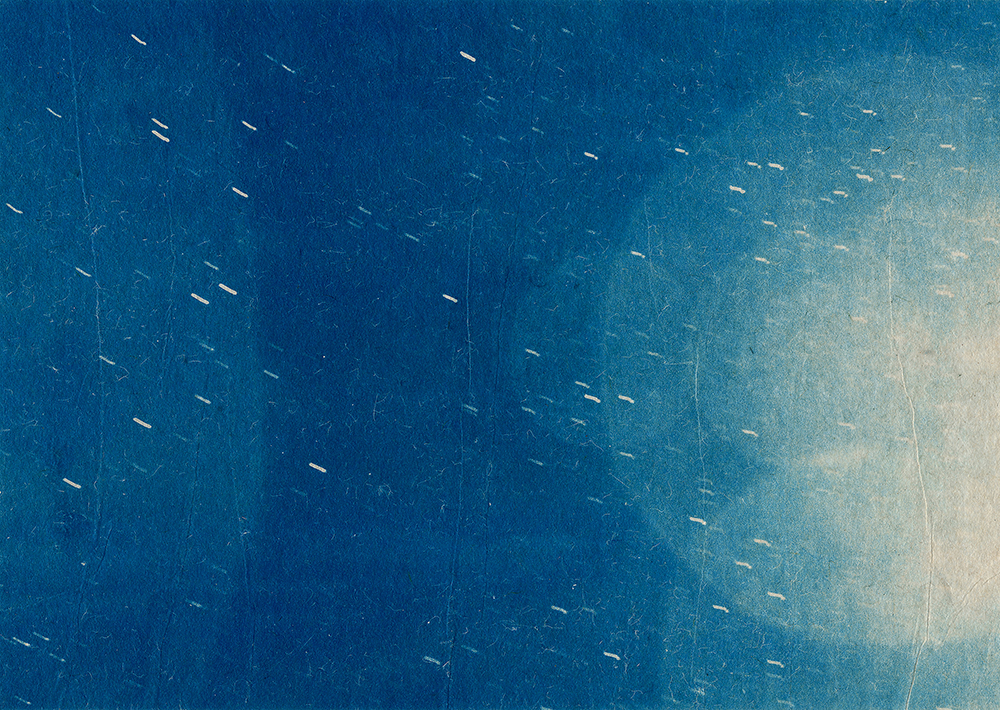
Julie van der Vaart
The Dance
Feb 05, 2024
Julie, a Dutch photographer, draws inspiration from literature, science, and existential inquiries. Grounded in the principles of quantum mechanics, her series 'The Dance' intricately captures the notion of matter as a dynamic flow of atoms, an ever-changing entity continuously assuming new forms.
Choosing cyanotypes as the optimal technique for this project, Julie has masterfully crafted a series of images that abstract the fundamental elements of life. In this collection, she skillfully reflects the inherent fluidity of existence, illustrating a reality where nothing is permanent—only atoms perpetually repositioning themselves. The result is an exquisite visual exploration of the transient and ever-evolving nature of our world.
First of all thank you very much for your contribution to our project. Can you please introduce yourself for us?
My name is Julie van der Vaart, I was born in The Netherlands and I live in a small village in Belgium, near the border with the Netherlands. There is one village between where I live and where I grew up as a child, my parents still live in the same house. I tried to live in a big city when I was a student, but I needed to be somewhere calm and close to nature, so I am happy and at home here.
I work as a guest lecturer at two schools, both for photography, and I work as an artist on my own projects. For my projects I love to work with different techniques, to learn new things and to work with my hands. Besides that I enjoy walking with my dog and reading books while drinking tea.
How did you start in photography?
As a teenager I did some drawing and painting, and I loved to collect magazines and make collages, my whole room was one big collage and I thought I wanted to become a fashion photographer, an idea I immediately dropped after the first year of studies. It is quite funny because I am not interested in fashion or fashion photography but that is where the interest in photography started. I did not grow up in an artistic family so I think fashion (& fashion photography) is a mainstream way of coming into contact with creativity.
At high school I studied science and mathematics and I thought I would pursue a study in that direction but I went for my gut feeling and my urge to express myself visually so I started studies in photography. And here we are.
What is ‘The Dance’ about?
Before ‘The Dance’ I worked for a few years on projects about time. I was interested in the questions: what is time, how is time studied, what are the different theories about time, how do I experience time.... And the concepts of deep time, imaginary time, non-lineair time.
It made sense to me that after reading about time I should read about matter, being.
I read the book ‘Reality is not what it seems’ by Carlo Rovelli, it fascinates me that in quantum mechanics, on the smallest scale, matter is not behaving like we are expecting. He writes about different ways to look at matter. For instance he says that instead of looking at a stone as “a thing” we should look at it as a temporal event of atoms that is now manifesting as this stone, but atoms are in constant motion and “things” are constantly changing. So one “thing” flows into another, and death is not death but just a re-positioning of atoms, a changing of matter and energy.
Life as a constant dance of atoms.
The project is like a song, it is an ode to the various forms of life and that everything is connected and in constant flux.
Why did you decide to make this series on cyanotype?
First of all, I enjoy working with different techniques and to experiment with them, so for each project I try to find the right technique for the concept and the images.
I chose cyanotypes for the colour and the process.
I do not use a lot of colors in my work but I do like blue, the colour of the sky and the sea, the colour of tranquility but also of sadness. And if I think about the concept behind the series in one way, if I can distance myself from myself, from my ego, it is a beautiful way to look at life, but when I think about my individuality, my ego, it also frightens me, I do not want to disappear.
Change means letting go and there is both beauty and sadness in that.
Cyanotypes is also a technique where you don’t need that much material, you have the mixture of ferric ammonium citrate and potassium ferricyanide to make the paper sensitive to light, but then you only need sunlight (or a UV lamp) and water to develop the image.
Sunlight and water, that made sense to me for this project about life.
And then I experimented with various papers and went for a textured kozo paper, which is quite thin but then at the same time also strong, when in water it will move like a piece of cloth and you have the feeling it will fall apart, but it’s stronger than it looks.
In general, what inspires your work?
Questions about what is reality, what is time. My experiences as a child with depersonalisation. Nature. And more than images, books, I find a lot of inspiration in books.
Who are your favourite photographers / artists?
There are lots of artists who I admire and there are different reasons to like or admire someone else’s work, sometimes I am moved by it, I find it beautiful, or, I think the artist is genius, the work is smart. So, here a just a few that I am thinking about right now:
Sophie Calle, Isabel Miquel Arques, Dirk Braeckman, Jungjin Lee, Kiki Smith, Gert Motmans, Yamamoto Masao, Daisuke Yokota.
What is your favourite photo book?
One of my favourite photography books is ‘Can’t pay you to disappear’ by Belgian photographer Thomas Vandenberghe.
Thank you very much for your time and contribution to analog magazine.
Thank you.
All images © Julie van der Vaart


















